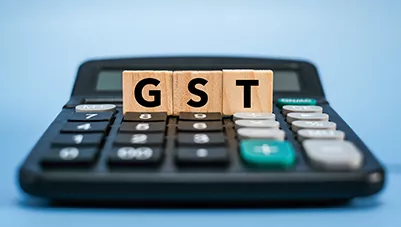GST state codes are unique two-digit alphanumeric codes assigned by the government to each state and union territory in India. GST state code is represented by numbers serially assigned to every state and Union Territory. As an example, GST state code 07 represents Delhi. Whereas, GST state code 29 represents Karnataka.
For a simpler understanding, the GST state code is mentioned in the Goods and Services Tax Identification Number (GSTIN). It is a unique 15-digit number provided by the government to any registered person or business entities under the Goods and Services Tax (GST) regime.

GST State Code List of India
| STATE NAME | GST CODE |
|---|---|
| JAMMU AND KASHMIR | 01 |
| HIMACHAL PRADESH | 02 |
| PUNJAB | 03 |
| CHANDIGARH | 04 |
| UTTARAKHAND | 05 |
| HARYANA | 06 |
| DELHI | 07 |
| RAJASTHAN | 08 |
| UTTAR PRADESH | 09 |
| BIHAR | 10 |
| SIKKIM | 11 |
| ARUNACHAL PRADESH | 12 |
| NAGALAND | 13 |
| MANIPUR | 14 |
| MIZORAM | 15 |
| TRIPURA | 16 |
| MEGHALAYA | 17 |
| ASSAM | 18 |
| WEST BENGAL | 19 |
| JHARKHAND | 20 |
| ODISHA | 21 |
| CHATTISGARH | 22 |
| MADHYA PRADESH | 23 |
| GUJARAT | 24 |
| DADRA AND NAGAR HAVELI AND DAMAN AND DIU (NEWLY MERGED UT) | 26* |
| MAHARASHTRA | 27 |
| ANDHRA PRADESH(BEFORE DIVISION) | 28 |
| KARNATAKA | 29 |
| GOA | 30 |
| LAKSHADWEEP | 31 |
| KERALA | 32 |
| TAMIL NADU | 33 |
| PUDUCHERRY | 34 |
| ANDAMAN AND NICOBAR ISLANDS | 35 |
| TELANGANA | 36 |
| ANDHRA PRADESH (NEWLY ADDED) | 37 |
| LADAKH (NEWLY ADDED) | 38 |
| OTHER TERRITORY | 97 |
| CENTRE JURISDICTION | 99 |
Where do we need State Code in GST?
(1) GST registration
Accurate and complete details must be entered by the applicant to obtain a valid GST registration. One such crucial information is the state and central jurisdictions for primary place of business. The information given by the taxpayer is verified by the officer. Thereafter, the applicant is allotted a GSTIN containing the relevant GST state code.
(2) GST invoice and e-Invoicing
GST state code becomes relevant for accurate invoicing and e-invoicing under GST. Valid GSTINs of buyer, seller and consignee contain the relevant state codes which are used to identify the place of supply of such sale. Eventually, place of supply decides type of GST to be charged based on whether it’s an interstate or intrastate sale.
Suppose, a seller mentions buyer’s GSTIN with a wrong GST state code on the invoice. Then, it may lead to wrong charge of IGST instead of CGST and SGST or vice versa with an incorrect place of supply being picked up.
If the seller happens to comply with e-invoicing by law, it can lead to cancellation of IRN due to incorrect state code GST and the need to raise invoice once again.
(3) GSTR-1 and GSTR-3B return reporting
Regular taxpayers must report B2B invoice details, including GSTIN, in the GSTR-1/IFF filed monthly or quarterly. These details are passed on to the respective GSTR-2A/GSTR-2B of the buyers, based on the GSTIN.
There is no mechanism or validation on the GST portal to confirm if a tax invoice bearing a particular buyer’s GSTIN is entered correctly in GSTR-1/IFF, unless it gets auto-populated from the e-invoice portal. Hence, if the seller erroneously mentions the wrong GST State code while entering GSTIN in invoice information in GSTR-1/IFF, the wrong person or GSTIN may end up finding tax credit in GSTR-2A/2B instead of the rightful buyer.
Classification of GST Jurisdiction
State Jurisdiction
State jurisdiction deals with tax administration within a specific state or union territory. It includes the assessment and collection of State GST (SGST) and Union Territory GST (UTGST). Each state is divided into various jurisdictions, each headed by a Jurisdictional Officer.
Central Jurisdiction
Central jurisdiction involves the administration of Central GST (CGST) and Integrated GST (IGST). It is responsible for transactions that occur between different states or union territories. The Central Jurisdiction ensures that taxes are appropriately collected and distributed among the states.
As outlined in CGST Circular no. 21/2017 dated 20th September 2017, here’s how the division is determined:
Taxpayers with Turnover Below ₹1.5 Crore: In this category, 90% of taxpayers whose total turnover falls below ₹1.5 crore are under the jurisdiction of the state administration, while the remaining 10% fall under the purview of the Central administration.
Taxpayers with Turnover Above ₹1.5 Crore: For taxpayers with a total turnover exceeding ₹1.5 crore, the division is more balanced. 50% comes under the state administration, while the other half is overseen by the Central administration.
This division of GST taxpayers is carried out through computer-initiated processes at the state level. It considers factors such as the geographical location of the taxpayer and the type of registration they hold.
How to Find or Know Your GST Jurisdiction?
Method 1: Through CBIC Portal (For State Jurisdiction)
- Visit the Central Board of Indirect Taxes and Customs (CBIC) portal (https://cbic-gst.gov.in/).
- On the CBIC portal, look for the ‘Services’ section.
- Find and click on the ‘Know Your Jurisdiction’ option.
- You will be directed to a page where you can access a list of States and Union Territories.
- Locate and select the State/UT for which you are looking for a GST jurisdiction list
- Select the zone
- After which you can select the commissionerate to proceed.
- Choose the division
- Select your range.
- Check and select the localities that fall under that range.
Method 2: Through GST Portal Using GSTIN (For Both State and Central Jurisdiction)
- Visit the official GST portal: GST Portal (https://www.gst.gov.in/).
- On the GST portal’s homepage, locate the ‘Search Taxpayer’ option
- In the dropdown, select ‘Search by GSTIN/UIN’.
- Enter the 15-digit GSTIN of the business or individual you want to inquire about.
- Click on the ‘Search’ or ‘Submit’ button.
- The portal will display detailed jurisdictional information, including both the State and Central Jurisdiction for the provided GSTIN.
Method 3: Through Individual State Websites
- Visit the official website of the specific state’s GST department.
- Look for a section or option related to GST or taxpayer services on the state’s website.
- Find the ‘Jurisdiction’ or ‘Know Your Jurisdiction’ option.
- Enter the required details, which may vary by state but typically include GSTIN or other relevant information.
- Click on the ‘Search’ or ‘Submit’ button.
- The state’s website will provide you with jurisdictional information specific to that state.
FAQs
What is GST State Code for Tamil Nadu?
33 is the Tamil Nadu GST State Code
What is GST State Code for Gujarat?
24 is the Gujarat GST State Code
